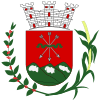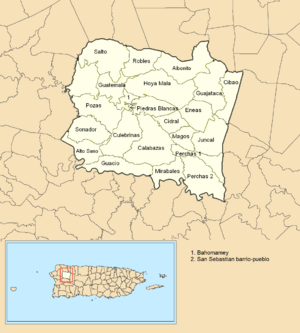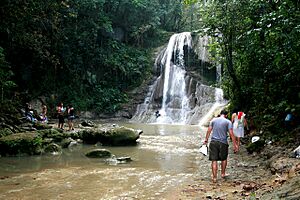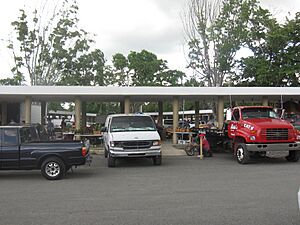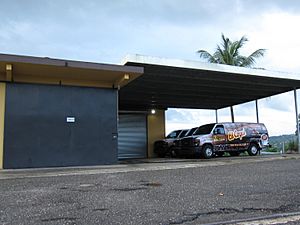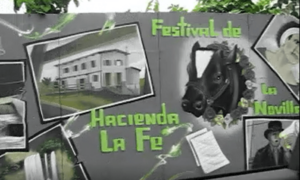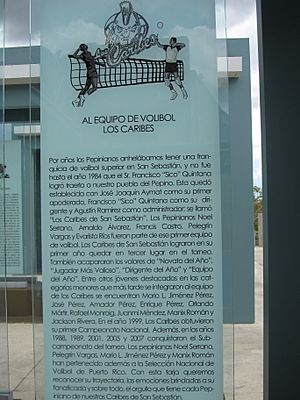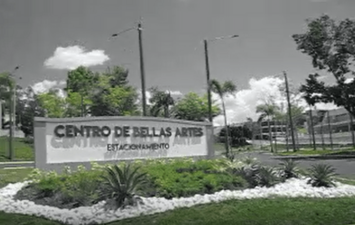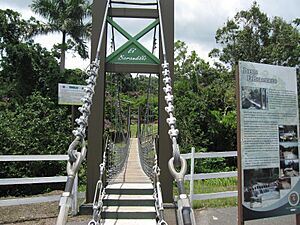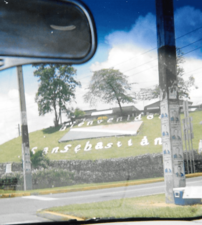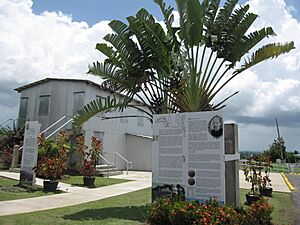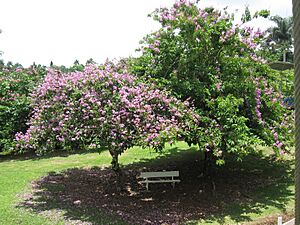San Sebastián, Puerto Rico facts for kids
Quick facts for kids
San Sebastián
Municipio Autónomo de San Sebastián
|
|||
|---|---|---|---|
|
Town and Municipality
|
|||
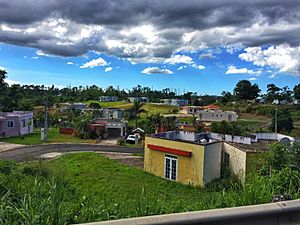
Neighborhood in San Sebastián
|
|||
|
|||
| Nicknames:
"San Sebastián Del Pepino", "Pepino", "Cuna de la Hamaca", "Los Patrulleros"
|
|||
| Anthem: "Van más de dos siglos de historia de vida" | |||

Map of Puerto Rico highlighting San Sebastián Municipality
|
|||
| Sovereign state | |||
| Commonwealth | |||
| Founded | September 20, 1752 | ||
| Founded by | Cristóbal González de la Cruz | ||
| Named for | Saint Sebastian | ||
| Barrios | |||
| Area | |||
| • Total | 71.7 sq mi (185.77 km2) | ||
| • Land | 71.4 sq mi (185.0 km2) | ||
| • Water | 0.3 sq mi (0.77 km2) | ||
| Population
(2020)
|
|||
| • Total | 39,345 | ||
| • Rank | 24th in Puerto Rico | ||
| • Density | 548.7/sq mi (211.794/km2) | ||
| Demonym(s) | Pepinianos | ||
| Time zone | UTC−4 (AST) | ||
| ZIP Code |
00685
|
||
| Area code(s) | 787/939 | ||
| Major routes | |||
San Sebastián is a town and municipality in Puerto Rico. It is located in the northwestern part of the island. The town is south of Isabela, Quebradillas, and Camuy. It is north of Las Marías. To its east is Lares, and to its west are Moca and Añasco.
San Sebastián has twenty-four areas called barrios. The main downtown area is called San Sebastián Pueblo. This town is an important part of the Aguadilla-Isabela-San Sebastián Metropolitan Statistical Area.
Contents
History of San Sebastián
San Sebastián was officially started in 1752. Captain Cristóbal González de la Cruz led the effort to create the town. He and other residents wanted to turn cow farms into a farming village. The religious founding of the town happened in December 1762. Mariano Martin, the island's Catholic bishop, completed this.
In the early 1700s, San Sebastián was a group of cow farms. These farms were owned by people from the Aguada area. One of the first farms was called Las Vegas. It was located by the Guatemala riverside. Another farm was called Pepinito, which is now the downtown area. Pepinito was a hill with a white, chalky face. You can still see some of these "pepinos" (which means "cucumbers") on the north side of town. These two farms gave the town its first name: Las Vegas del Pepino (Cucumber Fields). By 1865, it was known as San Sebastián de Las Vegas del Pepino.
In the early 1800s, rich Spanish families came to El Pepino. They were escaping wars in Venezuela and the Dominican Republic. Later, around 1850, families from Catalonia and the Basque Country in Spain also moved there. Many people from the Canary Islands had already made El Pepino their home. These new residents gained local political power. They developed a coffee industry and helped the town grow. The Basques remembered their home region and its patron saint. They started calling the town San Sebastián. The government officially changed the name in 1869. However, people from San Sebastián are still often called pepinianos.
Saint Sebastian the Martyr is the patron saint of archers. He was chosen as the town's patron saint early on. Immigrants from the Canary Islands first brought this tradition. The Basques later confirmed it when the town's name changed in 1869.
Hurricane Maria's Impact
Hurricane Maria hit Puerto Rico on September 20, 2017. It brought a lot of rain and caused many landslides in San Sebastián. The strong winds knocked out all the power. The town was left in darkness.
About 40,000 people in San Sebastián had no electricity. Two weeks after the hurricane, the mayor, Javier Jiménez, saw that help was not coming quickly. He decided San Sebastián would not wait for the main power company. He put together a special team of volunteers. Some were retired electricians from the power company. They set up safety rules. Their goal was to get electricity back for the people of San Sebastián.
Four months after the hurricane, they had restored power to 2,500 homes. They continued to fix about 60 homes each day. A monument was built to honor this group. They were quickly named the Pepino Power Authority. This monument is in Plaza de la Identidad Pepiniana in San Sebastián barrio-pueblo.
Geography of San Sebastián
San Sebastián is located in the northwest part of Puerto Rico.
Water Features
- Guajataca Lake
- Río Grande de Añasco
- Río Culebrinas
- Río Guajataca
Barrios of San Sebastián
Like all towns in Puerto Rico, San Sebastián is divided into areas called barrios. The main town buildings, central square, and large Catholic church are in a barrio called "el pueblo".
Special Communities
Some communities in Puerto Rico are called Comunidades Especiales (Special Communities). These are areas where people might face challenges. In 2014, some of these communities in San Sebastián included Guació barrio, Boquerón, Chinto Rodón, Estalingrado, Paralelo 38, Parcelas Perchas II, Pueblo Nuevo, and Tablas Astilla.
Population of San Sebastián
| Historical population | |||
|---|---|---|---|
| Census | Pop. | %± | |
| 1900 | 16,412 | — | |
| 1910 | 18,904 | 15.2% | |
| 1920 | 22,049 | 16.6% | |
| 1930 | 25,691 | 16.5% | |
| 1940 | 30,266 | 17.8% | |
| 1950 | 35,376 | 16.9% | |
| 1960 | 33,451 | −5.4% | |
| 1970 | 30,157 | −9.8% | |
| 1980 | 35,690 | 18.3% | |
| 1990 | 38,799 | 8.7% | |
| 2000 | 44,204 | 13.9% | |
| 2010 | 42,430 | −4.0% | |
| 2020 | 39,345 | −7.3% | |
| U.S. Decennial Census 1899 (shown as 1900) 1910–1930 1930–1950 1960–2000 2010 2020 |
|||
Tourism and Landmarks
Fun Places to Visit
The Veredas Sports Complex opened in 2016 in the Guatemala barrio. This complex has a modern skate park and a sand volleyball court. It also features a zipline with four stops and a climbing wall. There is an outdoor gym, a rope bridge, and courts for basketball and tennis. Walking paths wind through an urban forest with about six thousand trees. The Hacienda La Fe, an agriculture museum, is also located here.
Other interesting places in San Sebastián include:
- The Robles Waterfall is part of the Gozalandia waterfalls. It is a popular spot, but visitors should be very careful.
- The Church of Saint Sebastian the Martyr is in the Pueblo of San Sebastián. It is listed on the US National Register of Historic Places.
- A farmer's market is held every Friday at the Centro Agropecuario. You can buy local farm products and souvenirs there.
- The Casa de Doña Bisa Museum is across from the main square downtown. It shows what life was like in the early 1900s.
Other sites to see:
- Guajataca Lake
- Luis Aymat Cardona Coliseum
- Collazo Waterfall
- Hacienda El Jibarito
- Hacienda La Fe
- Juan Jose "Titi" Beniquez Stadium
- Luis Muñoz Marin Ground
- Guajataka Scout Reservation
Economy
Agriculture
San Sebastián is known for growing coffee and fruits. It also has many dairy farms. There is a coffee factory called El Coquí in Perchas 1, one of San Sebastián's barrios.
Transportation
San Sebastián has 30 bridges.
There is also a small air strip near the Culebrinas River. It is used for radio-controlled (RC) airplanes.
Culture
The town has a Fine Arts and Convention Center. It is called Centro de Convenciones y Bellas Artes. In early 2019, it was almost finished.
Festivals and Events
San Sebastián celebrates its patron saint festival in January. The Fiestas Patronales de San Sebastián is a religious and cultural event. It usually includes parades, games, local crafts, rides, food, and live music.
The San Sebastián Heifer Festival (Spanish: Festival de la Novilla) is the town's biggest festival. It happens every year on the first Sunday during the patron saint festival. Thousands of people attend. The celebration features carnival rides and different kinds of music of Puerto Rico. Cows decorated with flowers are part of the parade. There are also floats and Puerto Rican cuisine. In January 2016, the town celebrated its 40th Heifer festival.
Other festivals and events in San Sebastián include:
- Three Kings Day Festival – January
- Children's Festival – January
- Hammock Festival – July
- Lighting of the Christmas tree – November
- Cultural Evenings – third Thursday of the month
- Farmers' market – every Friday
Sports
The Los Caribes volleyball team plays their games at the Luis Aymat Cardona Coliseum.
In amateur baseball, the city's team is the Patrulleros de San Sebastián. They play at the Juan Jose "Titi" Beniquez Stadium. In 2019, they became champions of the Northwest area.
Symbols of San Sebastián
The municipio has an official flag and a coat of arms.
Flag
The flag is a rectangle with a white wavy band. This band separates a red top part from a green bottom part.
Coat of Arms
- The Mountains: These have silver borders. They show the special mountains where the town's namesake plant (cucumbers) grows.
- The Crown: This symbol is used to identify towns, villages, and cities.
- The sugar cane and coffee ranches represent the main farm products.
Notable People
- Juan Beníquez, a former center fielder in Major League Baseball.
- Ángel Mislan, (1862–1911) a musician and composer.
- Nilita Vientós Gastón, (1903–1989) an educator, writer, and journalist. She was the first woman president of the Puerto Rican Athenaeum.
- Luis V. Gutiérrez, the first Latino elected to Congress from the Midwest.
- Oscar Lopez Rivera, a political prisoner.
- Luz Odilia Font, a TV, theater, and film actress.
- Abimelec Torres, a contestant on Idol Puerto Rico.
- Estefania Soto Torres, Miss Universe Puerto Rico 2020 (she placed in the Top 10 at Miss Universe 2020).
Images for kids
See also
 In Spanish: San Sebastián (Puerto Rico) para niños
In Spanish: San Sebastián (Puerto Rico) para niños



